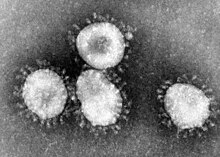
Back فيروس كورونا البشري 229E Arabic Coronavirus humà 229E Catalan Human coronavirus 229E Danish Humanes Coronavirus 229E German Ανθρώπινος κορονοϊος 229E Greek Human coronavirus 229E English Coronavirus humano 229E Spanish HCoV-229E Estonian کروناویروس انسانی ۲۲۹ئی Persian Ihmisen koronavirus 229E Finnish
| Coronavirus umano 229E | |
|---|---|
 | |
| Classificazione scientifica | |
| Dominio | Acytota |
| Ordine | Nidovirales |
| Famiglia | Coronaviridae |
| Genere | Alphacoronavirus |
| Sottogenere | Duvinacovirus |
| Nomi comuni | |
|
HCoV-229E | |
Il coronavirus umano 229E (HCoV-229E) è una specie di coronavirus che infetta l'uomo e i pipistrelli.[1] La specie appartiene al genere Alphacoronavirus ed è l'unica del sottogenere Duvinacovirus.[2][3]
È un virus a RNA avvolto a senso positivo, a singolo filamento, che entra nella sua cellula ospite legandosi al recettore APN.[4]
Insieme al coronavirus umano OC43 è uno dei virus responsabili del raffreddore comune,[5][6] ed è uno dei sette coronavirus umani (che includono HCoV-NL63, HCoV-OC43, HCoV-HKU1, MERS-CoV, SARS-CoV-1 e SARS-CoV-2) distribuiti a livello globale.[7][8]
- ^ Yvonne Xinyi Lim, Yan Ling Ng e James P. Tam, Human Coronaviruses: A Review of Virus–Host Interactions, in Diseases, vol. 4, n. 3, 25 luglio 2016, p. 26, DOI:10.3390/diseases4030026, ISSN 2079-9721, PMID 28933406.«See Table 1.»
- ^ (EN) Virus Taxonomy: 2018 Release, su International Committee on Taxonomy of Viruses (ICTV), October 2018. URL consultato il 13 January 2019.
- ^ Patrick C. Y. Woo, Yi Huang e Susanna K. P. Lau, Coronavirus Genomics and Bioinformatics Analysis, in Viruses, vol. 2, n. 8, 24 agosto 2010, pp. 1804-1820, DOI:10.3390/v2081803, ISSN 1999-4915, PMID 21994708.«Figure 2. Phylogenetic analysis of RNA-dependent RNA polymerases (Pol) of coronaviruses with complete genome sequences available. The tree was constructed by the neighbor-joining method and rooted using Breda virus polyprotein.»
- ^ Coronaviruses: an overview of their replication and pathogenesis, in Methods in Molecular Biology, vol. 1282, Springer, 2015, pp. 1-23, DOI:10.1007/978-1-4939-2438-7_1, ISBN 978-1-4939-2438-7, PMID 25720466.«See Table 1.»
- ^ Susanna K. P. Lau, Paul Lee, Alan K. L. Tsang, Cyril C. Y. Yip,1 Herman Tse, Rodney A. Lee, Lok-Yee So, Yu-Lung Lau, Kwok-Hung Chan, Patrick C. Y. Woo, and Kwok-Yung Yuen. Molecular Epidemiology of Human Coronavirus OC43 Reveals Evolution of Different Genotypes over Time and Recent Emergence of a Novel Genotype due to Natural Recombination. J Virology. 2011 November; 85(21): 11325–11337.
- ^ E. R. Gaunt,1 A. Hardie,2 E. C. J. Claas,3 P. Simmonds,1 and K. E. Templeton. Epidemiology and Clinical Presentations of the Four Human Coronaviruses 229E, HKU1, NL63, and OC43 Detected over 3 Years Using a Novel Multiplex Real-Time PCR Method down-pointing small open triangle. J Clin Microbiol. 2010 August; 48(8): 2940–2947.
- ^ Fields, B. N., D. M. Knipe, and P. M. Howley (ed.). 1996. Fields virology, 3rd ed. Lippincott-Raven, Philadelphia, PA.
- ^ Hoek, L. van der, P. Krzysztof, and B. Berkhout. 2006. Human coronavirus NL63, a new respiratory virus. FEMS Microbiol. Rev. 30:760–773. [PubMed]
